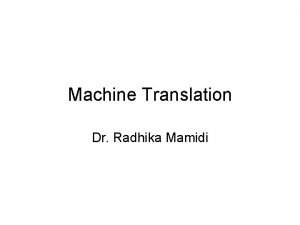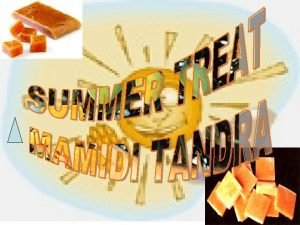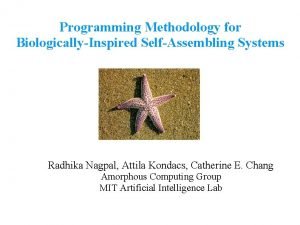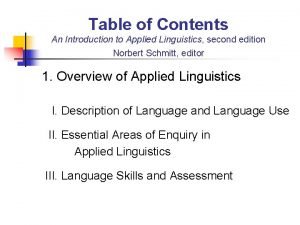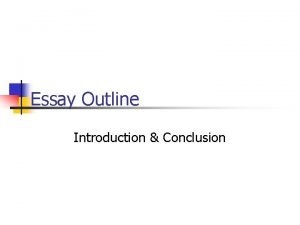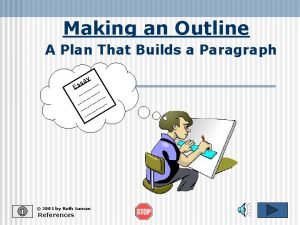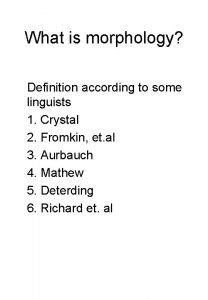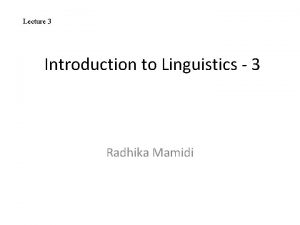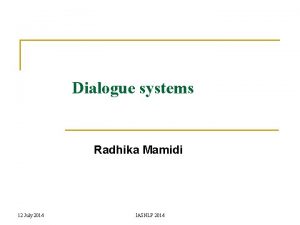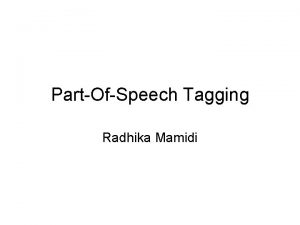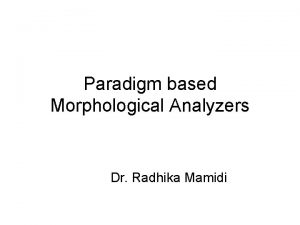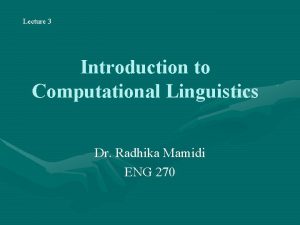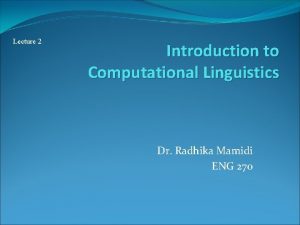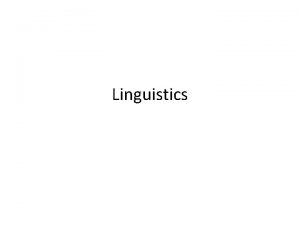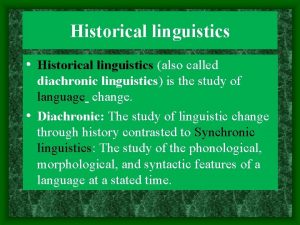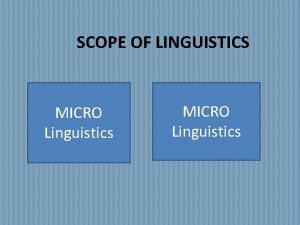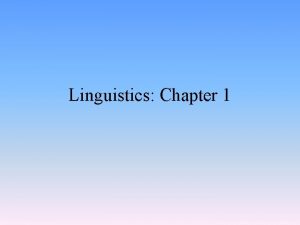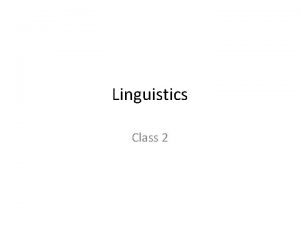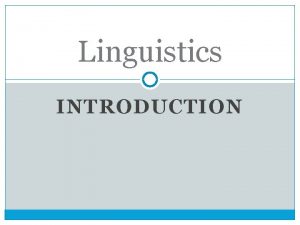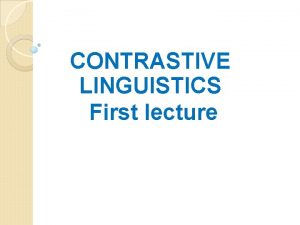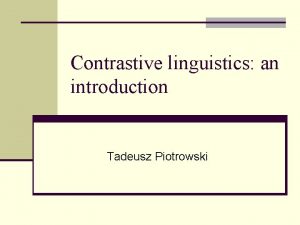Lecture 1 Introduction to Linguistics Radhika Mamidi Outline





![Origin of language • • Visual signals vocal signals [when dark] God Imitating birds Origin of language • • Visual signals vocal signals [when dark] God Imitating birds](https://slidetodoc.com/presentation_image_h2/641065307129d0b5f57629505dff1236/image-6.jpg)












![Assignment • Write about the history of your mother tongue. [1 -2 pages] • Assignment • Write about the history of your mother tongue. [1 -2 pages] •](https://slidetodoc.com/presentation_image_h2/641065307129d0b5f57629505dff1236/image-19.jpg)


- Slides: 21

Lecture 1 Introduction to Linguistics Radhika Mamidi

Outline • • • Human language features Writing systems Languages in contact Language change Language families

What is language?

What is language? It is a system of arbitrary signals, such as sounds, gestures or written symbols used for communicating thoughts, feelings, information etc. Is the definition complete?

![Origin of language Visual signals vocal signals when dark God Imitating birds Origin of language • • Visual signals vocal signals [when dark] God Imitating birds](https://slidetodoc.com/presentation_image_h2/641065307129d0b5f57629505dff1236/image-6.jpg)
Origin of language • • Visual signals vocal signals [when dark] God Imitating birds and animals Spontaneous singing while working

Human language features a. b. c. d. e. f. g. h. Duality of patterning Creativity Arbitrariness Displacement Redundancy Culture preserving and culture transmitting Dynamic Interchangeability (Charles F Hockett, 1958; Varma & Krishnaswamy, 1989)

Language and Media • Examples from Advertisements – less use of language. • Manipulate news • Striking headlines - language used creatively.




Writing systems • Pictographic or ideographic – each sign corresponds to an object or an idea • Logographic – each sign corresponds to a word • Syllabic - each sign corresponds to a syllabic • Alphabetic - each sign corresponds to a sound unit that makes a difference in meaning • Phonetic - each sign corresponds to a sound whether the sounds make a difference in meaning or not.

Varieties of language • • Dialects – regional, caste, prestige Standard dialect Idiolect Register, Styles Slang, Jargon Cant, Argot Spoken, written varieties

Language families • It’s estimated there are 6, 089 languages in the world grouped into language families. • Indo –European • Dravidian • Sino-Tibetan Based on • Austric or Nishaada Similarities and • Afro-Asiatic Difference • Niger-Congo • Malaya- Polynesian • Khosian

Language typologies • Typology Classification of languages based on order of verb, subject, and object in sentences. • Does not follow same groupings as families • SOV – Turkish, Japanese, Indian • SVO – English, Spanish, Russian • VSO – Irish, Scottish

Languages in contact • • Monolingualism Bilingualism Pidgin Creole Diglossia Code switching Code mixing

English-Hindi blended naturally

Language change – how? • • • Boredom – telephone, ring up, call New realities – brunch, motel Tendency to abridge – mike, telly, doc Change in meaning --- villain New meanings added – file, mouse
![Assignment Write about the history of your mother tongue 1 2 pages Assignment • Write about the history of your mother tongue. [1 -2 pages] •](https://slidetodoc.com/presentation_image_h2/641065307129d0b5f57629505dff1236/image-19.jpg)
Assignment • Write about the history of your mother tongue. [1 -2 pages] • Write about your knowledge of the language/s you know. [1 page] • Give 5 words to illustrate the type of changes that are taking place in your mother tongue. Comment.

Next lecture: What is Linguistics? • It is the scientific study of human language.

 Translate text from image
Translate text from image Chittibabu and chinnababu live in
Chittibabu and chinnababu live in Radhika nagpal
Radhika nagpal Language
Language History of applied linguistics
History of applied linguistics 01:640:244 lecture notes - lecture 15: plat, idah, farad
01:640:244 lecture notes - lecture 15: plat, idah, farad Lecture outline example
Lecture outline example Lecture outline example
Lecture outline example Lecture outline example
Lecture outline example Lecture outline meaning
Lecture outline meaning The study of language george yule
The study of language george yule Answer key
Answer key An introduction to applied linguistics norbert schmitt
An introduction to applied linguistics norbert schmitt Indexicality
Indexicality Quotation sandwhich
Quotation sandwhich Introduction to biochemistry lecture notes
Introduction to biochemistry lecture notes Introduction to psychology lecture
Introduction to psychology lecture Introduction to algorithms lecture notes
Introduction to algorithms lecture notes Conclusion paragraph outline
Conclusion paragraph outline 5 paragraph essay outline
5 paragraph essay outline Software engineering 1 course outline
Software engineering 1 course outline Morphology definition linguistics examples
Morphology definition linguistics examples
